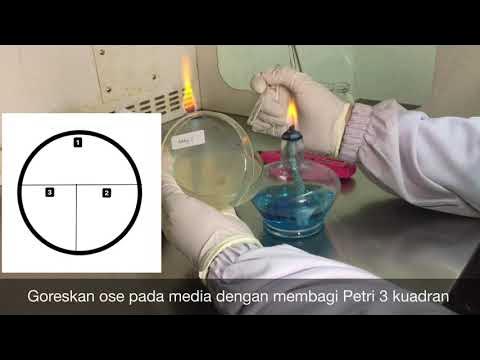Video 3 Teknik isolasi bakteri dengan metode Spread Plate
Summary
TLDRThis microbiology practicum video demonstrates the technique of isolating bacteria using aseptic methods. Key steps include collecting bacterial culture with a micropipette, spreading it on an agar plate with a sterile rod, and ensuring all tools are sterilized with a bunsen burner. The video emphasizes aseptic technique to avoid contamination and the importance of proper handling throughout the process. This tutorial is essential for students learning lab practices in microbiology.
Takeaways
- 😀 The practicum teaches techniques for isolating bacteria in microbiology.
- 😀 The first technique covered is 'software,' which involves using specific equipment like micropipettes and bacterial culture.
- 😀 Aseptic techniques are emphasized throughout the process to avoid contamination.
- 😀 Bacterial culture is collected using a micropipette and heated with a Bunsen burner to ensure sterility.
- 😀 The bacteria culture is then spread onto an agar plate to grow.
- 😀 The use of alcohol-soaked swabs and heating with a Bunsen burner ensures proper aseptic technique during handling.
- 😀 Before spreading the bacteria, the rod used for spreading should be cooled down to avoid killing the bacteria.
- 😀 After spreading the bacteria on the agar plate, it is left to dry before further incubation.
- 😀 The bacterial culture is carefully handled to ensure no contamination occurs during the process.
- 😀 After the bacteria is spread on the agar plate, the Petri dish is closed, sterilized, and set aside to allow drying.
Q & A
What is the purpose of the microbiology practicum mentioned in the video?
-The practicum is designed to teach students the technique of isolating bacteria using various laboratory methods, focusing on aseptic techniques and the use of specific tools like micropipettes and agar plates.
What are the three techniques taught in this practicum?
-The three techniques are software technique, inoculation, and incubation.
What tools are required for the first technique (software technique)?
-For the software technique, you need bacterial culture, agar plate media, a micropipette, a Bunsen burner, and an aseptically prepared rod.
Why is sterilization important in this experiment?
-Sterilization is essential to prevent contamination from foreign bacteria and ensure that only the intended bacterial culture is used in the experiment.
How is the bacterial culture transferred to the agar plate in the software technique?
-The bacterial culture is transferred using a micropipette, and the transfer is done aseptically to prevent contamination.
What should you do after using the rod for spreading the bacterial culture?
-After using the rod to spread the bacteria, you should sterilize it again by heating it with a Bunsen burner flame and then placing it back in alcohol solution.
What is the role of the Bunsen burner in this experiment?
-The Bunsen burner is used for sterilizing tools such as the rod and ensuring that they are free from contaminants before use in the experiment.
How do you ensure that the rod used for spreading is safe to touch the agar plate?
-Before using the rod, you must make sure it has cooled down after being heated over the Bunsen burner, ensuring that it is not too hot to damage the agar or affect the bacteria.
What happens after the bacterial culture is spread on the agar plate?
-Once the bacterial culture is spread, the agar plate is left to dry, and the experiment is followed by further incubation and observation of bacterial growth.
Why is aseptic technique emphasized throughout the practicum?
-Aseptic technique is crucial to prevent contamination, ensuring that the experiment is carried out accurately and that the isolated bacteria are not influenced by external microorganisms.
Outlines

This section is available to paid users only. Please upgrade to access this part.
Upgrade NowMindmap

This section is available to paid users only. Please upgrade to access this part.
Upgrade NowKeywords

This section is available to paid users only. Please upgrade to access this part.
Upgrade NowHighlights

This section is available to paid users only. Please upgrade to access this part.
Upgrade NowTranscripts

This section is available to paid users only. Please upgrade to access this part.
Upgrade NowBrowse More Related Video
5.0 / 5 (0 votes)





